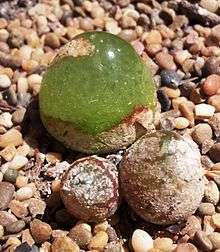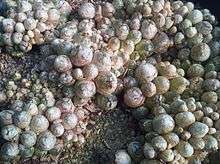Conophytum burgeri
Conophytum burgeri ("Burger's onion") is a small, endangered, South African species of succulent plant, of the genus Conophytum.
| Conophytum burgeri | |
|---|---|
 | |
| Conophytum burgeri in cultivation | |
| Scientific classification | |
| Kingdom: | Plantae |
| Clade: | Tracheophytes |
| Clade: | Angiosperms |
| Clade: | Eudicots |
| Order: | Caryophyllales |
| Family: | Aizoaceae |
| Genus: | Conophytum |
| Species: | C. burgeri |
| Binomial name | |
| Conophytum burgeri L.Bolus | |
Description

An onion-shaped, single-bodied, succulent plant, it is possibly the most unusual of all the species of the genus Conophytum. It has a tiny fissure at the top of its body. Its epidermis is smooth, shiny and translucent, and its colour is light green to purple. It is slow-growing and sometimes subdivides through a gradual process over several years, to form two or even three heads. It varies in size and can reach the size of a small onion.
Unlike most other Conophytums, it grows in a region of spring and early summer rainfall. However its habitat is extremely arid, and the plant may rely mainly on the copious winter fogs and dew that condenses on the rocks where it grows. When dormant, its outer covering dries into a thin, white, persistent leaf-sheath.
It produces a purple flower, in early autumn (April–May in South Africa), with the aroma of honey. The flowers open briefly in the late afternoon, has over 5 sepals and a long stigma (over 10mm).
Relatives and distinguishing features
Some of its closest relatives such as Conophytum ratum, Conophytum achabense, Conophytum hammeri and Conophytum subterraneum do have a similar cone shape. Conophytum burgeri can be distinguished from these by its long stigma (over 10mm) and by its epidermis becoming purple to red in direct sunlight. (Conophytum subterraneum for example, has a stigma under 7mm long, and remains a green colour). Conophytum ratum has a larger fissure (3-4mm) that is embedded or sunken in the body. Conophytum achabense has only 4 sepals, and Conophytum hammeri has an obscure translucent window at its apex.
Distribution
This species is endemic to Bushmanland in the Northern Cape Province, South Africa, where it is known from the mines of the Aggeneys valley (between Sprinbok and Pofadder).
Here it grows on high, open, raised, exposed flats, in rocky clay soil, which is strewn with white quartz pebbles that keep the soil relatively cool.
Aggeneys was the farm of the Burger family, and it was named after the farmer Willem Burger, who noticed the unusual plant and contacted the botanist H.C. Kennedy.[1]
Cultivation
Water
The desert habitat of this species receives its sparse rainfall mainly in Spring and early Summer, with very little rainfall in the winter. The plants may receive water from dew or condensation in the winter, because in cultivation Conophytum burgeri can be treated as a winter-rainfall species, like most other Conophytum species. All Conophytums have an annual growing period when they receive some water, and a dry dormancy period. In their growing period the soil must always dry out completely between waterings. In their dormancy they can be left dry and only given water if they visibly start to shrivel. Alternatively, Conophytum burgeri can be given water occasionally throughout the year, at intervals of a week or two. It shrivels when it needs more water; and it splits open when it receives too much. Seeds can be sown in early Summer, and given light watering regularly for a year, before the seedlings begin their annual dormancy periods.
Soil
They grow well in shallow pots, and require extremely well-drained soil. A coarse or porous shale mixture, with little to no organic component, best approximates their natural soils in habitat.
Sunlight and temperatures
They require direct and plentiful sunlight. It can be given slight shelter at the peak of the hottest summer days. A cooler temperature at night and good ventilation is also beneficial for the plants.[2]
| Wikimedia Commons has media related to Conophytum burgeri. |
Further reading
- Hammer,S.(2002) Dumpling and his wife: New views of the genus Conophytum EAE Creative Colour Ltd. ISBN 0-9539326-1-3.
- Hammer,S.(1993) The genus Conophytum : A Conograph Succulent Plant Publications, Pretoria. ISBN 0-620-17633-4.
- National Botanical Institute of South Africa.(1993) List of Southern African Succulent Plants Umdaus Press. ISBN 1-919 766-04-9